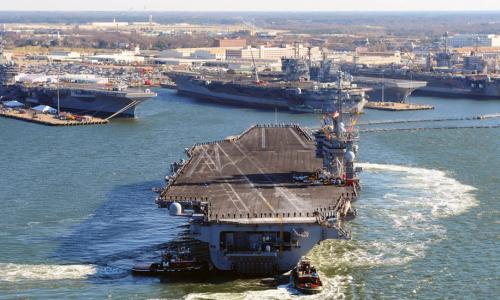Low-lying Florida faces rising sea levels along its entire 1,200-mile coastline.
The situation is particularly acute in the Florida Keys, where most of the land area lies at elevations of three feet or less above sea level.
Seas are projected to rise more than that in this region—between 3.8 and 6.2 feet—over the course of this century.
Base information
This location is one of 18 military installations featured in the 2016 report, "The US Military on the Front Lines of Rising Seas."
NAS Key West provides key training and support for the nation’s military operations and readiness. The 5,800-acre installation trains fighter pilots from all branches of the armed forces. The station can house 100 aircraft and more than 800 personnel while also providing port operations for visiting ships.
NAS Key West is also home to several important commands, including the Joint Interagency Task Force South, which combats illicit narcotics trafficking; the US Coast Guard Sector Key West; and the Army Special Forces Underwater Training School.
Projected exposure to coastal flooding
The base's exposure to coastal flooding is projected for the years 2050, 2070, and 2100 based on the National Climate Assessment’s midrange or “intermediate-high” sea level rise scenario (referred to here as “intermediate”) and a “highest” scenario based on a more rapid rate of increase.
Tidal flooding, land loss, and storm surge from hurricanes were all modeled. In this analysis, land inundated by at least one high tide each day is considered a loss. This is a conservative metric: in reality, far less frequent flooding would likely lead to land being considered unusable.
The results below outline potential future flooding scenarios for NAS Key West, assuming no new measures are taken to prevent or reduce flooding.
Preparing for rising seas
The gap between the military’s current preparedness for sea level rise and the threats outlined here is large and growing.
In order to plan effectively for the long term, military decision makers with authority over NAS Key West need to understand how sea level rise may permanently alter the landscape of this coastal installation and where the threat of storm surge may become intolerable.
To take action, however, individual installations like NAS Key West will need more detailed analysis and resources to implement solutions.
Congress and the Department of Defense should, for example, support the development and distribution of high-resolution hurricane and coastal flooding models; adequately fund data monitoring systems such as our nation’s tide gauge network; allocate human, financial, and data resources to detailed mapping and planning efforts at military installations; and, as adaptive measures are identified, allocate resources for these projects, many of which will stretch over decades.
Our defense leadership has a special responsibility to protect the sites that hundreds of thousands of Americans depend on for their livelihoods and millions depend on for national security.
Additional maps and resources
This analysis modeled exposure to coastal flooding for four different points in time (2012, 2050, 2070, and 2100) and two different sea level rise scenarios.
For each time horizon and scenario, we analyzed storm surge from Category 1 through 5 hurricanes, the extent and frequency of flooding from extra-high tides, and inundation from ordinary high tides.
Detailed maps for each scenario at NAS Key West are available via Dropbox.
For more, please see the methodology used for this analysis.




